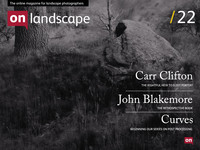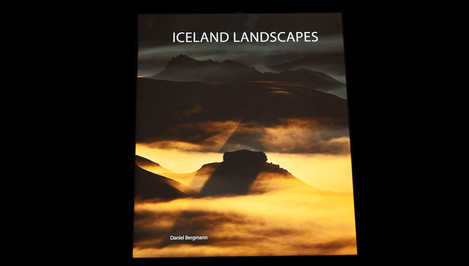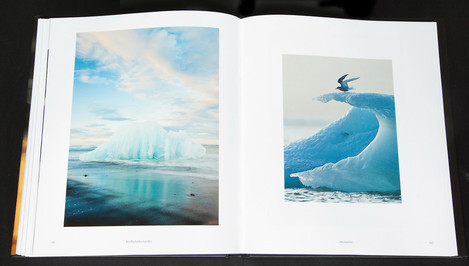Book review

Adam Pierzchala
Now retired, I have more time to enjoy being out with my camera looking for scenes and subjects that pique my interest, especially coastal, woodland and close-ups. Although I still have several rolls of 35mm and MF film in my freezer, I shoot almost exclusively digital now
I came across Daniel Bergmann’s book quite by chance; it was lying on a coffee table in a remote hotel in the Icelandic Highlands. I was there on a photo tour run by Nature Explorer, an excellent local family-run company. But more of that in another article…
Daniel Bergmann was a new name to me and although it is a landscape book that I review here he is apparently known for superb bird photography. Certainly, his website showcases a number of fine images of different genres. On leafing through the book I was immediately drawn into his uncomplicated yet powerful and inspiring landscape photographs. Nearly all work is on two levels – descriptive and interpretative going beyond the obvious subject depicted on the page. In fact, I was so impressed with this work that I thought he shoots large format and I was strangely disappointed to discover that he uses a Canon DSLR. This probably says more about my prejudice that LF photographers produce better work than users of other media – despite me not being a LF user myself!
But back to Bergman’s book: apart from the excellent photography, the juxtaposition of images on adjacent pages has been very carefully thought through and it is noteworthy that Bergman did the book design himself. There is a thoughtful foreword by Pall Asgeir Asgeirsson, an Icelandic writer, and a very complimentary introduction by none other than David Ward. To see his name in a book laid out for hotel guests, in the middle of nowhere, was a total surprise – and an additional factor in my buying the book. A rich portfolio of photos follows the introduction and in my limited experience of Iceland, it seems to be a first-class distillation of the country’s tremendously varied landscape and light. The author then presents his own Reflections on Photography in Iceland and the book ends with interesting and helpful notes on each image. Daniel Bergman has the ability to make even the most photographed locations look like new discoveries and is a master at intriguing near-far compositions. With 143 pages the book is a truly inspiring work.
It has been customary in these book reviews to home in on selected photographs and page spreads but I find it really difficult to select just a few that give a sense of the rich beauty in this book – they are all so good. However, let me try and pick a few pairs of well matched photographs: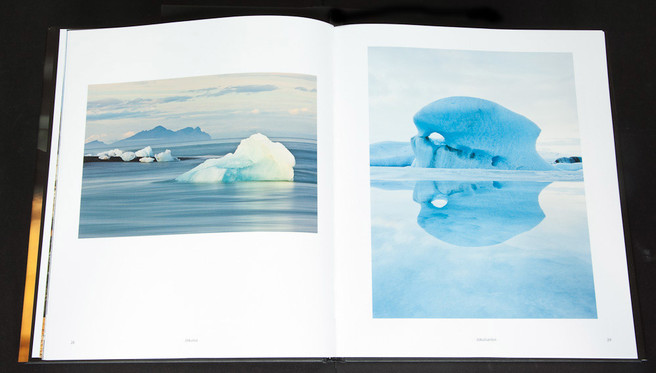
On page 28 on the left we have a beautifully lit iceberg with soft yellows from the setting sun contrasting with the cool colours of distant hills, yet also complementing them with the similarity of shape. Even the clouds in the sky are echoes of smaller icebergs stranded on the black sand beach. On the right page (page 29), a perfectly reflected blue iceberg creates a symmetrical photo which makes me think of an axe head. Two beautiful photos, essentially of ice, yet with inspiring colour contrast and very different moods.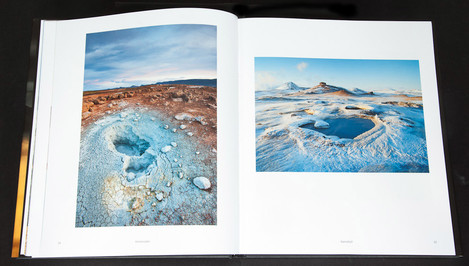
In complete contrast, the spread on pages 34–35 shows geothermal activity in the form of fumaroles so utterly alien that the pictures seem to be from another planet in its earliest primordial stages of being formed. Similar subject matter though from two different areas, similar colours yet in very different light create a pair of very fine intriguing landscapes. Both combine detail in the foreground fumaroles with a grand vista stretching to mountains on the horizon.
I was impressed with the two images on pages 48–49 which are abstracts of brown rock and snow on the left page and of beige sand on the right. The similarity in the shapes and in the restricted colour palette makes this pair work very well together even though I find neither photograph especially appealing on its own.
One other pair which I find works well is this: on the left on page 54 an image of dense yellowish fog streaming in over Latrabjarg cliffs. The bright fog seems to hug the clefts in the dark cliffs creating a strong vertically layered effect and a good sense of depth. On the right, page 55, and contrasting in colour is an image of clouds reflected in shallow sea water on the beach at Leirur. There is a small area of raised black sand which works perfectly as a foil to the bright reflection of a hole in the cloud making the whole scene quite surreal. Not only do both photos have their own contrasting tonal range, but the cool blue evening tones of the second photo work well with the yellow of the fog in the first. Quite masterly. But only a few days after I first looked at this pair I suddenly noticed that there are birds (puffins???) flying around the cliff, tiny specks which somehow soften the stark scene.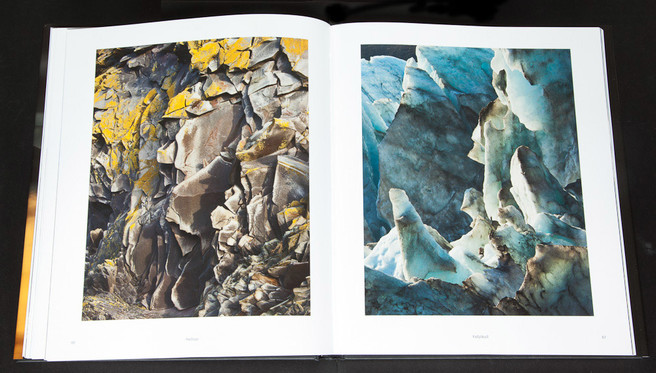
Another wonderful pair is on pages 60–61, showing in abstraction: the warm toned rock detail at Hellnar in comparison with cold blue ice seracs on Falljokull. A very strong colour contrast, yet the two images are united by the macro-detail of rock and ice formations. Here again, the individual images are not my favourites, but as a pair, they work very well indeed.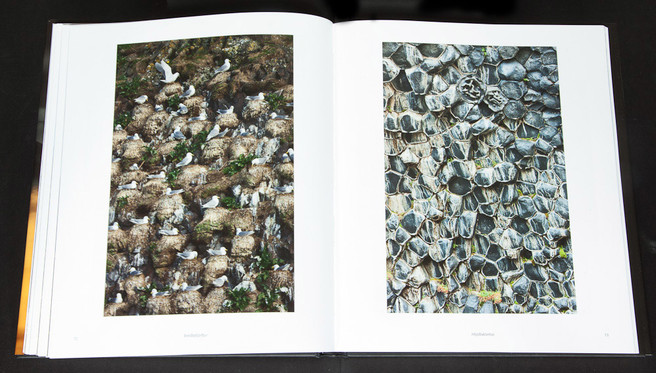
An astonishing pairing on pages 72–73 is that of a Kittiwake colony, with the birds scattered on small shelves on a cliff, with a photo of the ends of basalt columns which seem to mimic the pattern of the birds on the left page. It takes a very creative mind to pair two such utterly different subjects!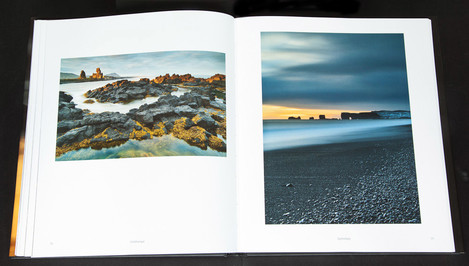
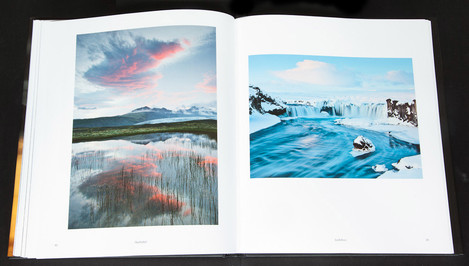
There are many images which are wonderful as stand-alone pictures: a beautiful sunset over the black beach at Dyrholaey (p71), pink clouds reflected in a pond at Skaftafell (page 80), and a perfectly caught arctic tern on page 107, whose wings seem to mimic the shape of the iceberg on which it is perched. And there are so many more!
But the one that will most likely stay in my mind is of Melrakkasletta taken after midnight in June. As Bergmann himself says it seems to be a photo of nothing – some jagged rocks scattered around on a vast sandy plain. The muted orange-red light shining on those rocks is repeated in a sky laden with soft clouds almost like veils draped horizontally from the ceiling. It’s an image of wonderful simplicity yet draws me in and I feel that I too would like to be there with my camera. The day after I saw this photo, in the late afternoon, we drove through a similar desolate field of jagged rocks strewn over black sandy/stony ground. Back at the hotel, as the sun was setting I was desperate to go back, to create my own homage to Bermann. But dinner was being served and the photo I would have made remains in my mind’s eye. It is probably far better than anything that I have committed to film – clearly the one that got away!
This is a superbly produced book of beautiful images of a beautiful country. It’s that simple.
[We have contacted Beyond Words and Neil is checking to see if he can source copies so try emailing directly for now and I'll put a link up here once we have a confirmation of this - ed]

